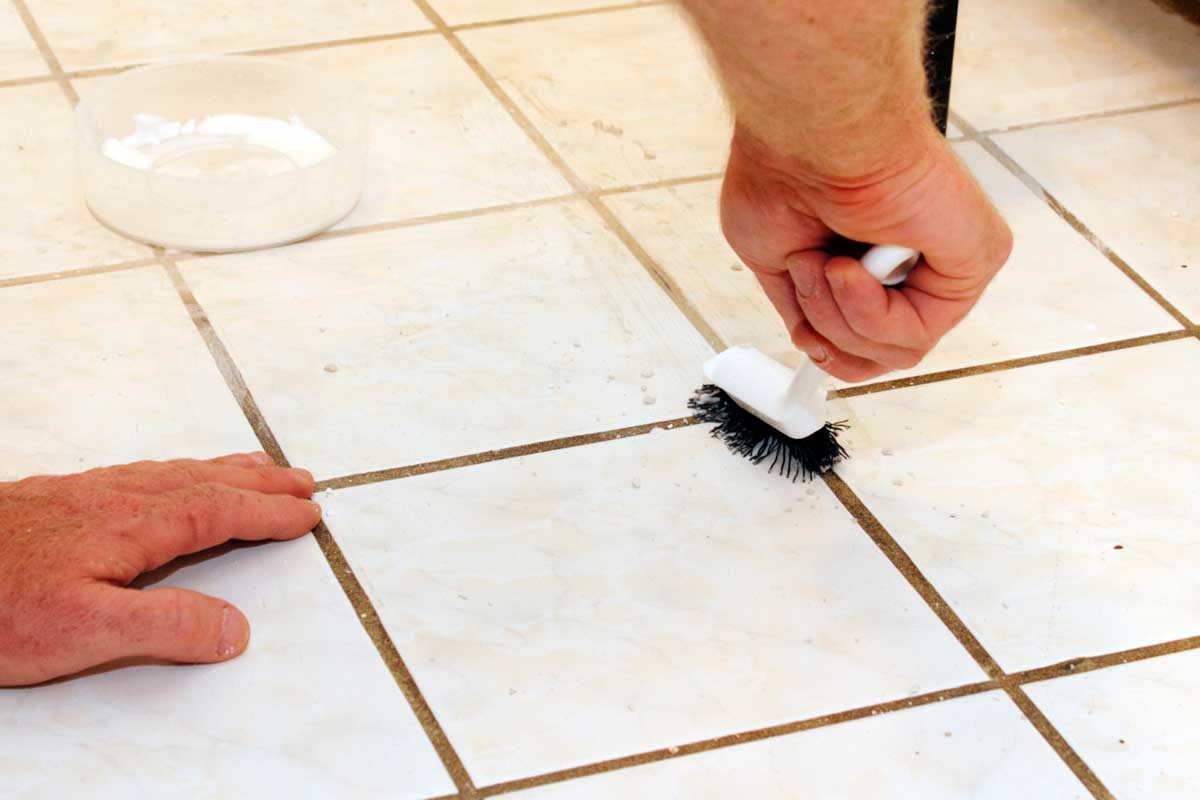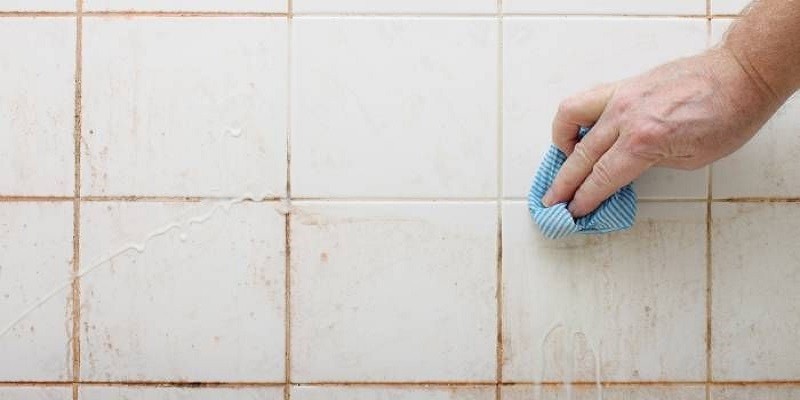Last Updated on September 11, 2023
To clean black grout, mix equal parts of white vinegar and water, apply the solution to the grout, scrub with a brush, and rinse thoroughly. The black color is likely caused by dirt and mold buildup, which can be effectively removed with this vinegar solution.
Cleaning grout regularly can prevent it from turning black and keep it looking clean and fresh. Regular maintenance, such as scrubbing with a brush and using a grout sealer, can also help maintain the cleanliness and appearance of grout. Additionally, proper ventilation and reducing moisture in the area can prevent mold and mildew growth, which can contribute to grout discoloration.

Credit: homedecorbliss.com
The Causes Of Black Grout
Grout turning black can be caused by various factors such as mold, mildew, dirt, or lack of maintenance. To clean it effectively, use a mixture of baking soda and hydrogen peroxide, scrub the grout, and rinse thoroughly for a fresh and clean look.
Grout turning black can be quite frustrating, especially when you’ve put in the effort to keep your tiles clean. Understanding the causes behind this discoloration can help you tackle the problem effectively. In this section, we will discuss the factors that contribute to grout turning black and the common sources of stains and discoloration.
Factors That Contribute To Grout Turning Black:
- Moisture: Excessive moisture is one of the leading causes of black grout. When water and moisture seep into the grout, it creates the perfect environment for mold, mildew, and bacteria to thrive, resulting in black stains.
- Lack of ventilation: Poor ventilation in bathrooms, kitchens, or any area where grout is present can lead to increased humidity and moisture buildup. This lack of airflow creates an ideal breeding ground for blackening grout.
- Inadequate sealing: Grout that has not been properly sealed is susceptible to absorbing dirt, stains, and moisture. Over time, this can lead to the grout turning black.
- Age and wear: As grout ages, it can become worn down, cracked, or damaged. These imperfections make it easier for dirt and stains to accumulate, eventually causing the grout to darken.
Common Sources Of Stains And Discoloration In Grout:
- Mold and mildew: These fungal growths thrive in damp environments and can quickly take hold in grout, leading to black discoloration. Bathrooms and areas with high moisture levels are particularly vulnerable to mold and mildew growth.
- Dirt and debris: Regular foot traffic can bring in dirt, dust, and debris, which can settle into the porous surface of grout. Over time, this can result in the grout appearing black and dirty.
- Soap scum: Soap residues and hard water deposits can build up on grout surfaces, causing a grimy film to develop. This accumulation can contribute to the grout turning black.
- Stains from spills: Liquid spills, especially those containing highly pigmented substances like coffee, wine, or oil, can leave unsightly stains on grout. If not cleaned up promptly and thoroughly, these stains can darken the grout over time.
- Chemical reactions: Cleaning products that are acidic or contain bleach can react with the grout’s composition, leading to discoloration. It’s essential to use appropriate cleaning agents for your specific type of grout.
Understanding the factors that contribute to grout turning black and the common sources of stains and discoloration within grout will help you take proactive steps to keep your tiles looking clean and fresh. In the next section, we will explore effective methods for cleaning black grout.
Effective Cleaning Solutions For Black Grout
Discover effective cleaning solutions to tackle black grout and restore its original shine. With these expert tips, you can easily clean grout that has turned black, achieving impressive results effortlessly.
Maintaining clean grout is an essential part of keeping your tiles looking fresh and preventing the growth of mold and mildew. However, over time, grout can turn black due to dirt buildup, moisture, or the growth of bacteria. If you’re facing this issue, there are several effective cleaning solutions that you can try.
Here are some natural and chemical-based options along with their pros and cons:
Natural Cleaning Options:
- White vinegar: Vinegar is an excellent natural cleaner that can help remove stubborn stains from grout. Mix equal parts of water and white vinegar, then apply the solution to the affected areas. Scrub the grout using a stiff brush and rinse with water.
- Pros: Vinegar is an eco-friendly and inexpensive solution that effectively removes grout stains. It also has antibacterial properties.
- Cons: Vinegar has a strong smell and can be corrosive if not diluted properly. It may not be suitable for use on certain types of tiles, such as marble or natural stone.
- Baking soda: Baking soda is a versatile cleaner that can tackle grout stains effectively. Make a paste by mixing baking soda with water, then apply it to the grout lines. Leave it for a few minutes, scrub with a brush, and rinse with water.
- Pros: Baking soda is non-toxic, affordable, and readily available. It helps to remove stains and eliminates odors.
- Cons: It may require some effort and multiple applications to achieve the desired results. Baking soda can scratch delicate tiles, so use caution.
- Lemon juice: The acidic properties of lemon juice make it a powerful grout cleaner. Squeeze fresh lemon juice directly onto the blackened grout, allow it to sit for a few minutes, and scrub with a brush. Rinse thoroughly with water.
- Pros: Lemon juice is a natural disinfectant and deodorizer. It’s a cost-effective solution that leaves a refreshing scent.
- Cons: Lemon juice may cause discoloration on some types of grout or tiles. It may require multiple applications for heavily stained grout.
Chemical-Based Cleaning Options:
- Bleach: Bleach is a strong cleaning agent that can effectively remove black grout stains. Mix one part bleach with three parts water, apply the solution to the grout, and let it sit for about 10 minutes. Scrub the grout using a brush and rinse well with water.
- Pros: Bleach is a powerful disinfectant that effectively kills bacteria and removes tough stains. It works quickly and is readily available.
- Cons: Bleach can damage or lighten colored grout, so use it with caution. It also emits strong fumes, so make sure the area is well-ventilated. Avoid using bleach on porous materials.
- Commercial grout cleaners: There are various commercial grout cleaners available in the market that specifically target black grout stains. Follow the instructions provided on the product packaging for the best results.
- Pros: Commercial grout cleaners are specially formulated for grout cleaning and can be highly effective. They save time and effort.
- Cons: Some commercial cleaners may contain harsh chemicals that can be harmful if not used properly. Always follow the instructions and exercise caution.
Remember to test any cleaning solution in a small, inconspicuous area before applying it to the entire grout surface. Additionally, ensure proper ventilation during the cleaning process and wear appropriate protective gear, especially when using chemical-based cleaners. With the right cleaning method and a little effort, you can effectively clean black grout and restore the beauty of your tiles.
Step-By-Step Guide To Cleaning Black Grout
Clean black grout easily with this step-by-step guide. Discover effective techniques to restore the look of your grout, leaving it clean and bright.
Grout, being porous in nature, easily absorbs dirt and grime over time, resulting in a blackened appearance that can be visually unappealing. Luckily, with the right cleaning process, you can restore your grout to its former clean and bright state.
Follow this step-by-step guide to effectively clean black grout:
Preparing The Cleaning Solution:
- Mix 1 part vinegar with 1 part water in a spray bottle. Vinegar’s natural acidity makes it an excellent cleaning agent for grout.
- Alternatively, you can create a paste by combining baking soda and hydrogen peroxide. This powerful mixture works wonders in tackling deep-seated grout stains.
Applying The Solution To The Grout:
- Begin by spraying the vinegar and water solution generously onto the blackened grout. Ensure the solution covers the entire affected area.
- For a paste solution, spread it over the grout lines using an old toothbrush or a grout brush. Make sure to apply an even layer and let it sit for a few minutes to allow the cleaning agents to penetrate the grout.
Scrubbing And Agitating The Grout:
- Using a scrub brush or an old toothbrush, vigorously scrub the grout lines in a circular motion. Keep in mind that grout is a delicate material, so use gentle pressure to avoid damaging it.
- Pay extra attention to stubborn stains and heavily soiled areas, giving them a little more scrubbing time to effectively remove the blackened grout.
Rinsing And Drying The Grout:
- Once you’re satisfied with the cleaning, rinse the grout thoroughly with clean water. You can use a damp cloth or sponge to wipe away any residual cleaning solution.
- To ensure the grout dries properly, allow it to air dry, or if desired, use a dry cloth or towel to gently pat it dry. Avoid walking on the freshly cleaned grout until it is completely dry to avoid any potential damage.
By following these step-by-step instructions, you can successfully clean black grout and restore its original cleanliness and brightness. Regular maintenance and cleaning will keep your grout looking its best, preventing it from turning black again in the future. Start the cleaning process and enjoy the fresh and rejuvenated look of your grout!
Preventing Black Grout In The Future
Preventing black grout in the future is crucial, and cleaning grout that has turned black requires some specific steps. By regularly cleaning and sealing grout, using proper cleaning solutions and techniques, and addressing any underlying issues, you can keep your grout looking fresh and preventing it from turning black.
Grout that has turned black can be a frustrating problem to deal with. However, with the right maintenance and sealing techniques, you can prevent black grout from happening in the future. Here are some helpful tips to keep your grout clean and looking its best:
Maintenance Tips To Keep Grout Clean And Prevent Discoloration:
- Regular cleaning: To prevent grout from turning black, make sure to clean it regularly by using a mixture of warm water and mild detergent. Scrub gently using a brush or sponge, and remember to rinse thoroughly.
- Avoid harsh cleaners: Harsh chemical cleaners may damage the grout and cause discoloration. Stick to mild cleaners that are specifically formulated for grout cleaning.
- Dry the surface: After cleaning, it’s important to dry the grout thoroughly to prevent moisture buildup. Use a clean, dry cloth or towel to wipe away any excess moisture.
- Ventilate the area: Proper ventilation in areas with grout, such as bathrooms and kitchens, can help reduce mold and mildew growth. Make sure to open windows or use exhaust fans to promote air circulation.
Best Practices For Sealing Grout To Protect Against Stains:
- Choose the right sealer: When selecting a grout sealer, opt for a high-quality product that is suitable for your specific type of grout. There are different sealers available for different grout materials like sanded or unsanded grout.
- Prepare the surface: Before applying the sealer, ensure that the grout is clean and dry. Remove any dirt, debris, or existing sealant using a grout cleaner or a brush.
- Apply the sealer: Follow the instructions provided by the sealer manufacturer for proper application. Use a brush or applicator to evenly coat the grout lines. Allow the sealer to dry according to the recommended time.
- Regular resealing: Over time, grout sealers can wear off. To maintain protection against stains and discoloration, make sure to reseal your grout periodically. The frequency will depend on the type of sealer and the level of use in the area.
By following these maintenance tips and best practices for sealing grout, you can effectively prevent black grout and keep your surfaces looking clean and fresh. Remember to stay on top of regular cleaning and maintenance to avoid future grout discoloration.
Frequently Asked Questions Of How To Clean Grout That Has Turned Black?
What Does It Mean When Grout Turns Black?
Grout turning black is a common issue due to mold and mildew growth. This occurs when moisture gets trapped in the grout lines, providing a suitable environment for these organisms to thrive. Lack of ventilation, high humidity, and poor cleaning practices can contribute to grout discoloration.
To prevent grout from turning black, it is essential to keep the area well-ventilated and control humidity levels. Regular cleaning with a mild detergent can also help remove dirt and bacteria before it becomes a problem. For existing black grout, there are specialized grout cleaners available that can effectively eliminate mold and mildew stains.
It’s important to follow the manufacturer’s instructions and test the cleaner in a small, inconspicuous area first. In conclusion, when grout turns black, it is likely a result of mold and mildew growth. By implementing proper cleaning and maintenance practices, you can keep your grout looking clean and prevent further discoloration.
How Do You Make Black Grout White Again?
To make black grout white again, follow these steps: 1. Scrub the grout lines with a mixture of water and bleach. 2. Use a grout brush or an old toothbrush to scrub the grout vigorously. 3. Let the bleach solution sit on the grout for a few minutes.
4. Rinse the grout thoroughly with clean water. 5. For stubborn stains, mix baking soda with hydrogen peroxide to form a paste. 6. Apply the paste to the grout and let it sit for about 15 minutes. 7. Scrub the grout again with a brush and rinse it off.
8. Dry the grout completely to avoid future mold or mildew growth. Regular maintenance can help prevent the grout from turning black again. Clean it regularly with mild soap and water, and avoid using harsh chemicals that may damage the grout.
What Is The Best Product To Clean Black Grout With?
The best product to clean black grout is a grout cleaner specifically formulated for removing stains from dark grout lines. Use a small brush to apply the cleaner to the grout and scrub gently. Rinse the area thoroughly with water and dry with a clean cloth.
For stubborn stains, you may need to repeat the process or try a stronger cleaning solution. Avoid using bleach or harsh chemicals, as they can damage the grout or surrounding surfaces. It’s also a good idea to wear gloves and ensure proper ventilation when using any cleaning product.
Regular maintenance and prevention, such as sealing the grout, can help maintain its cleanliness and prevent future stains.
How Do I Clean Black Grout In My Shower?
To clean black grout in your shower, mix equal parts of baking soda and water to form a paste. Apply the paste to the grout, scrub with a brush, and rinse off.
Conclusion
To sum up, tackling black grout can be a challenging task, but with the right techniques and products, you can restore its original cleanliness and brightness. Start by gathering all the necessary supplies, such as a grout brush, vinegar, baking soda, hydrogen peroxide, and a steam cleaner.
Then, prepare a homemade cleaning solution by combining vinegar and baking soda or hydrogen peroxide and baking soda. Apply the solution to the blackened grout lines, let it sit for some time, and scrub thoroughly using the grout brush. For more stubborn stains, opt for a steam cleaner to penetrate deep into the grout and lift the dirt.
Finally, remember to maintain the cleanliness of your grout by regularly wiping it down and using preventative measures such as sealing. By following these steps, you can ensure that your grout remains clean and free from unsightly black stains.










